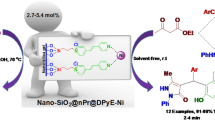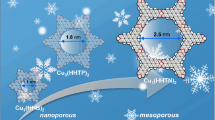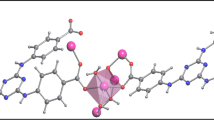Abstract
A novel (Me3PhCH2N)2[MoFe4S4(SC6H11)7] cubane-like cluster was obtained from a reaction system including (NH4)2MoS4, FeCl2 and NaSC6H11 in methanol, and characterized by X-ray crystallography. The title compound crystallizes in triclinic space group\(P\bar 1\) witha = 1.523 1(3), b =1.610 5(3),c = 1.838 3(4) nm, α = 77.18 (3)°, β = 75.17(3)°, γ = 64.60(3)°, and Z = 2. Also included in this paper are the discussions on the variation of the reaction products obtained from the participation of cyclohexylthiolate and on the changes of the structural features of the products.
Similar content being viewed by others
References
Chan, M. K., Kim, S., Rees, D. C., The nitrogenase Fe-Mo cofactor and P-cluster pair: 2.2 Å resolution structures,Science, 1993, 269: 792.
Holm, R. H., Trinuclear cuboidal and heterometallic cubane-type iron-sulfur clusters: New structural and reactivity themes in chemistry and biology,Advances in Inorganic Chemistry, 1992, 38: 1.
Wolff, T. E., Power, P. P., Frankel, R. B. et al., Synthesis and electronic redox properties of “double-cubane” cluster complexes containing MoFe3S4 and WFe3S4 cores,J. Am. Chem. Soc., 1980, 102: 4694.
Zhang, Y. P., Bashki, J. K., Holm, R. H., Phosphine cleavage of iron (III)-bridged double cubanes: A new route to MoFe3S4 single cubanes,Inorg. Chem., 1987, 26: 694.
Liu, Q. T., Huang, L. R., Liu, H. Q. et al., Structural chemistry of molybdenum-iron-sulfur cluster compounds with a single-cubane [ MoFe3S4 ]n+ (n = 4–6) core and crystal structure of [MoFe3S4(Me2dtc)5] 2CH2Cl2,Inorg. Chem., 1990, 29: 4131.
Nordlander, E., Lee, S. C., Cen, W. et al., Heterometal cuboidal clusters MFe4S6(PEt3)4Cl (M = V, Mo): Synthesis, structural analysis by crystallography and EXAFS, and relevance to the core structure of the iron-molybdenum cofactor of nitrogenase,J. Am. Chem. Soc., 1993, 115: 5549.
McDonald, J., Frieser, G. D., Rosenhein, L. D. et al., Syntheses and characterization of ammonium and tetraalkylammonium thiomolybdates and thiotungstates,Inorg. Chim. Acta, 1983, 73(2): 205.
Wolf, T. E., Berg, J. M., Holm, R. H., Sythesis, structure and properties of the cluster complex [MoFe4S4(SC2H5)3- (C6H4O2)3]3- containing a single cubane-type MoFe3S4 core,Inorg. Chem., 1981, 20: 174.
Henkel, G., Chen, C. N., Controlling the number of bridging ligands in binuclear iron thiolate complexes by modulation of ligand nucleophilicities: [Fe2 (SC4H9)5]-, the first complex containing FeS4 tetrahedra connected via common faces, and [Fe2(SC3H7)6]2-, a complex with a bitetrahedral M2S6 framework of conventional design,Inorg. Chem., 1993, 32:1064.
Author information
Authors and Affiliations
Additional information
Project supported by the National Natural Science Foundation of China and the Climbing Program—State Key Project for Fundamental Research in China, and Hong Kong Research Grants Council (Earmarked Grant No. CUHK. 311/94p).
Rights and permissions
About this article
Cite this article
Chen, C., Deng, Y., Hong, M. et al. Synthesis and structure of a novel MoFe4S4 cubane-like cluster (Me3PhCH2N)2 [MoFe4S4 (SC6H11)7]. Sc. China Ser. B-Chem. 41, 301–308 (1998). https://doi.org/10.1007/BF02879711
Received:
Issue Date:
DOI: https://doi.org/10.1007/BF02879711




